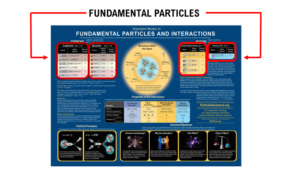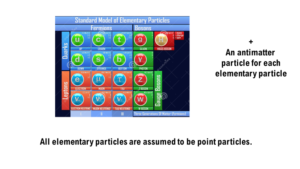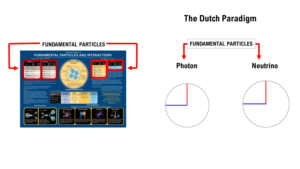POINT PARTICLES
Fundamental or Elementary Particles as declared in the Standard Model, are assumed to be Point Particles. Particles are divided into Fermions and Bosons. This relative to a characteristic called spin. Bosons have spin=1 and Fermions spin=1/2, values attributed per definition.

Fermions are so-called mass carriers and appreciated as the base ingredient for matter. In the classical physics observed in everyday life, matter is any substance that has mass and takes up space by having volume. That includes atoms, and anything made up of these, but not other energy phenomena or waves such as light or sound.
Fermions are subdivided into two categories, being Leptons and Quarks. Leptons can be observed in naked form, while Quarks are a constituent of another particle. They have not been observed in a naked form.

The fundamental particles are assumed to be point particles. The defining feature is that it lacks spatial extension: being zero-dimensional, it does not take up space. It is obvious that it is hard to accept that a particle that does not take up space has characteristics that eventually allow to build up to an object that we can observe. Hence, modern physics theories such as String Theory start with the axiom that all physical entities have a spatial extension. However small they may be. But, if it has spatial extension and mass, then the next question is: does it have substance and by what definition?
The fundamental particle is there, but we can only observe it through its respective manifestations. It is not physically tangible and alike a pedestrian that marks its footprint but is afterward invisible as a person.
Within The Dutch Paradigm, I accept the fundamental particles as point particles not having a spatial extension. I rather like to use the notion of entity. It is a thing with distinct and independent existence; it is a thing-in-itself is a property-bearer that must be distinguished from the properties it bears. It is as defined by Immanuel Kant.
The fundamental particles are assumed to be point particles. The defining feature is that it lacks spatial extension: being zero-dimensional, it does not take up space. It is obvious that it is hard to accept that a particle that does not take up space, has characteristics that eventually allow to build up to an object that we can observe. Hence, modern physics theories such as String Theory start with the axiom that all physical entities have spatial extension, however small they may be. But, if it has spatial extension and mass, then the next question is: does it have substance and by what definition?
The fundamental particle is there, but we can only observe it through its respective manifestations. It is not physically tangible and alike a pedestrian that marks its footprint but is afterward invisible as a person.
Within The Dutch Paradigm, it is accepted that the fundamental particles as point particles not having a spatial extension. Instead of point particles, we prefer to use the notion of entity. It is a thing with distinct and independent existence; it is a thing-in-itself is a property-bearer that must be distinguished from the properties it bears. It is as defined by Immanuel Kant
Immanuel Kant argued the sum of all objects, the empirical world, is a complex of appearances whose existence and connection occur only in our representations. Kant introduces the thing-in-itself as follows:
And we indeed, rightly considering objects of sense as mere appearances, confess thereby that they are based upon a thing in itself, though we know not this thing as it is in itself, but only know its appearances, viz., the way in which our senses are affected by this unknown something.
— Prolegomena, § 32
Now, if all elementary particles are point particles, then it is difficult to visualize how combinations of these elementary particles can result in constructs that are physically tangible.
In regular science, we identify a phenomenon that is defined as the Pauli Exclusion Principle.

This principle describes that certain types of point particles are not allowed to take the same position in space. It governs the rules that we can stand on the floor rather than sink through. It provides matter with the ability to become tangible.
It also allows for the macrocosmic behavior of matter as we experience in our daily life. We experience gravitation, we know that we have to exert a force to accelerate matter and crashing to a sudden stop is painful.
In the Standard model is accepted that mass can be a property of an elementary point particle and mass apparently does not require a spatial extension.

The idea that mass does not require spatial extension is difficult to comprehend. For Particle Physics, is, therefore, a convention to use as metrics for the property mass the equivalent of its energy content as per the famous equation E=mc² of Albert Einstein.

I have earlier on in this series postulated that the only elementary particles that exist in the universe are photons and neutrinos and by definition, these are point particles.

It is a challenge for me to demonstrate and explain how these two elementary particles in mutual interference show mass-like behavior, more specifically show gravitational and inertia to a world outside of their existence.
We know the photon as the prime source of light and electromagnetic radiation and must get a better understanding of the properties and behavior of the neutrino. It will be discussed this in subsequent chapters.
